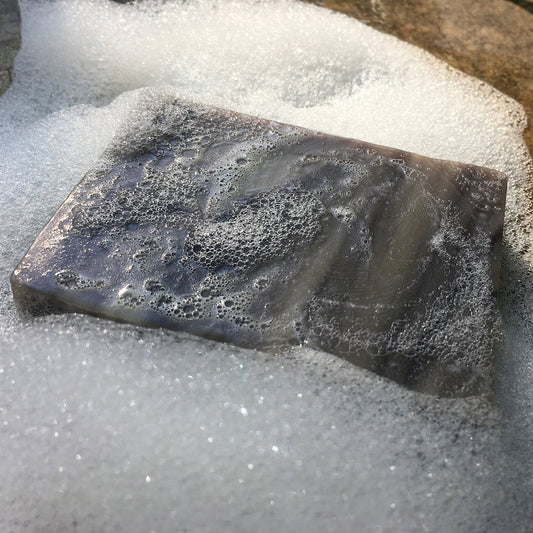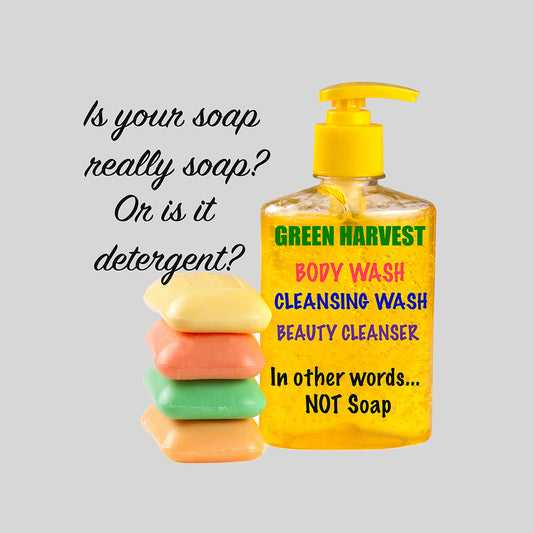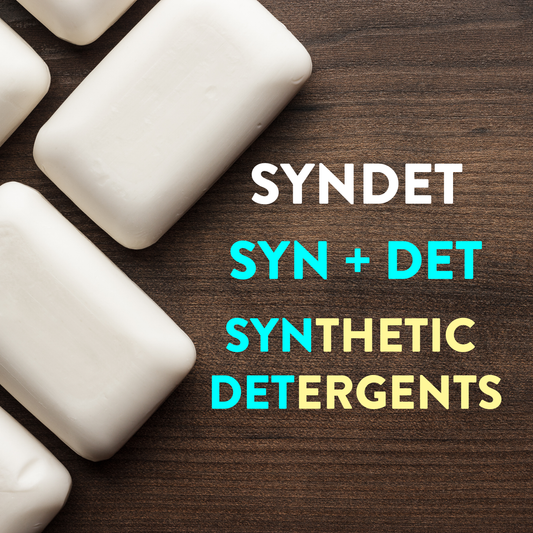How Does NATURAL Soap Work?
The science of how things work has always fascinated me. So, How Does Soap Work?
You have probably heard the saying about "oil and water” which compares two things that do not go together well or two people who are not compatible or do not get along.
For example, no matter how vigorously you shake salad dressing made with oil and vinegar (which is 95% water) it always separates into two layers. This is because oil molecules and water molecules are not compatible and do not get along.
 If you wash with plain water, it will not remove greasy dirt off your body. That’s why we need soap.
If you wash with plain water, it will not remove greasy dirt off your body. That’s why we need soap.
How Does Soap Work?
Soap, water, and oil are all made up of molecules. Some molecules are hydrophilic, (hydro = water and philic loving) these molecules are attracted to water.
Some molecules are hydrophobic, (hydro = water and phobic = fearing), they are repelled by water.
Water and anything that will mix with water is hydrophilic.
Oil and anything that will mix with oil is hydrophobic.
We all know that when water and oil are mixed they separate. Hydrophilic and hydrophobic compounds just do not mix.
Polar vs Non Polar Molecules
Molecules can also be grouped as polar or non-polar molecules. Some molecules may be in between the two.
In simple terms, polar means oppositely charged, and non-polar means equally charged. The basis of polar and nonpolar molecules comes from electrical charges on the atoms in the molecules.
Atoms are made of small particles. The nucleus in the center of the atom is made up of neutrons, which have no charge, and protons, which have a positive charge. Circling around the nucleus are the negative electrons.
When atoms bond together to form molecules, they share or give electrons. If the electrons are shared equally by the atoms, then the molecule has no electrical charge, and the molecule is nonpolar.
Polar molecules have a positive or negative charge. When the arrangement of the atoms in a molecule is such that one end of the molecule has a positive electrical charge and the other side has a negative charge, the molecule has electrical poles and is called a polar molecule.
 Whether molecules are polar or non-polar determines how well they mix together.
Whether molecules are polar or non-polar determines how well they mix together.
Nonpolar compounds, like oil and grease, cannot dissolve in water. Polar compounds dissolve in water.
Most of what we call dirt is grease or oil which will not come off with just water.
This is because oil and grease are non-polar, which means they will not dissolve in the water. But soap can mix with both water and oil. Why?
The soap molecule has two different ends, one that is hydrophilic (polar head) that binds with water and the other that is hydrophobic (non-polar hydrocarbon tail) that binds with grease and oil.
Since soap molecules have both properties of non-polar and polar molecules soap can act as an emulsifier. An emulsifier is simply an additive that helps two liquids mix.
When greasy dirt, fat, or oil is mixed with soapy water, the soap molecules arrange themselves into tiny clusters called micelles.
The soap molecules work as a bridge between polar water molecules and non-polar oil molecules.
 The red water-loving (hydrophilic) head of the soap molecules sticks to the water and points outwards, forming the outer surface of the micelle.
The red water-loving (hydrophilic) head of the soap molecules sticks to the water and points outwards, forming the outer surface of the micelle.
The oil-loving (hydrophobic) black squiggly tail sticks to the oil and trap oil in the center where it can't come into contact with the water.
With the oil trapped safely in the center, the micelle is soluble in water. As the soapy water is rinsed away the greasy dirt goes along with it.
Ever wonder why it is easier to clean dirty, greasy hands (and other things) in hot or warm water rather than cold water? It is because the fats and oils soften or melt in hot water, which allows them to attach more readily to the hydrophobic end of the soap molecule. In turn, that makes it easier to rinse away.
Soap is a natural surfactant
A surfactant is any substance that tends to reduce the surface tension of a liquid in which it is dissolved.
The formulas for cleansing products are based on surfactants.
Synthetic surfactants also reduce the surface tension of the water and their structure is similar to that of soap with a hydrophilic (polar) head and a hydrophobic (non-polar) tail. Thus, detergents are also compatible with both water and oil.
 This property is what makes them good for cleansing. When surfactants like natural soap or synthetic detergents lower the surface tension of water, they basically make the water molecules more slippery, so they are less likely to stick to themselves and more likely to interact with oil and grease.
This property is what makes them good for cleansing. When surfactants like natural soap or synthetic detergents lower the surface tension of water, they basically make the water molecules more slippery, so they are less likely to stick to themselves and more likely to interact with oil and grease.
Unlike body washes, soap needs no synthetic additives to create lather or to clean because natural soap is a natural surfactant. So it not only makes great bubbles and lather, but it also helps clean oily dirt from your skin--naturally!
You can think of soap as the middle-man that helps bring oil and water together so that the dirt and grease on your skin can be easily rinsed away.
Since some sort of surfactant is needed to wash oily dirt away if the cleansing product you are using on your face, body, or hair is not real soap, then it is made with synthetic surfactants, basically detergents.
For more information and cute video about surface tension read our blog: "How Does Natural Soap Create Lather?"
To find the one that's right for you, browse our full range of natural soaps.


